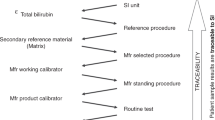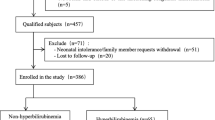Abstract
Objective
Measure daily bilirubin-binding capacity (BBC) variation using an automated, not as-yet FDA approved, Point-of-Care hematofluorometer. Measure the effects of prematurity, clinical instability and exposure to Intralipid on BBC.
Subjects
Convenience sample of 109 infants from well-baby and intensive care nurseries. Gestational ages 28–41 weeks. 261 specimens obtained from postnatal ages 1–4 days. Unstable neonates were defined by need for at least noninvasive respiratory support and FiO2 ≥ 0.25.
Results
Median interday variation was 2.9 ± 5.1 mg/dL. BBC (0.254 mg/dL/wk) and albumin (0.037 g/dL/wk) increased for each week of gestation. BBC was lower in unstable compared to well infants (26.1 ± 7.6 mg/dL v 28.6 ± 6.3 mg/dL). BBC was not significantly different in infants receiving or not receiving IL.
Conclusions
BBC measurements using the device had acceptable intraspecimen reproducibility and interday variability. BBC may be helpful in guiding the assessment of aggressive versus conservative management decisions in preterm and sick infants with hyperbilirubinemia.
This is a preview of subscription content, access via your institution
Access options
Subscribe to this journal
Receive 12 print issues and online access
$259.00 per year
only $21.58 per issue
Buy this article
- Purchase on Springer Link
- Instant access to full article PDF
Prices may be subject to local taxes which are calculated during checkout



Similar content being viewed by others
References
American Academy of Pediatrics Subcommittee on Hyperbilirubinemia. Management of hyperbilirubinemia in the newborn infant 35 or more weeks of gestation. Pediatrics. 2004;114:297–316.
Maisels MJ, Watchko JF, Bhutani VK, Stevenson DK. An approach to the management of hyperbilirubinemia in the preterm infant less than 35 weeks of gestation. J Perinatol. 2012;32:660–4.
Watchko JF, Tiribelli C. Bilirubin-induced neurologic damage-mechanisms and management approaches. N Engl J Med. 2013;369:2021–30.
Ahlfors CE, Wennberg RP, Ostrow JD, Tiribelli C. Unbound (free) bilirubin: improving the paradigm for evaluating neonatal jaundice. Clin Chem. 2009;55:1288–99.
Lamola AA, Bhutani VK, Du L, Cuadrado MC, Chen L, Shen Z, et al. Neonatal bilirubin binding capacity discerns risk of neurological dysfunction. Pediatr Res. 2015;77:334–9.
Shell BC, Lees H, Li PK. Mechanism of interference by hemoglobin in the determination of total bilirubin. II. Method of Jendrassik-Grof. Clin Chem. 1980;26:26–9.
Doumas BT, Watson WA, Biggs HG. Albumin standards and the measurement of serum albumin with bromcresol green. Clin Chim Acta. 1971;31:87–96.
Bhutani VK, Johnson L, Sivieri EM. Predictive ability of a predischarge hour-specific serum bilirubin for subsequent significant hyperbilirubinemia in helthy term and near term infants. Pediatrics. 1999;103:6–14.
Chetta KE, Pham O, Tyson JE, Pedroza C, Bhutani VK, Castillo Cuadrado ME, et al. Measuring bilirubin binding capacity in very low birthweight newborns. EPAS. 2018;2360:7.
Lamola AA, Fanaroff AA. Bilirubin fluorescence and prevention of kernicterus. Diagn Med. 1984;7:9–12.
Watchko JF, Spitzer AR, Clark RH. Prevalence of hypoalbuminemia and elevated bilirubin/albumin ratios in a large cohort of infants in the neonatal intensive care unit. J Pediatr. 2017;188:280–6.
Morioka I, Kurokawa D, Iwatani S, Iijima H, Lamola AA, Bhutani VK, et al. Monitoring bilirubin binding parameters in a cohort of Japanese neonates. J Clin Lab Med. 2018;3. https://doi.org/10.16966/2572-9578.119.
Muramoto Y, Matsushita M, Irino T. Reduction of reaction differences between human mercaptalbumin and human nonmercaptalbumin measured by the bromcresol purple method. Clin Chem Acta. 1999;289:69–78.
Ahlfors CE, Bhutani VK, Wong RJ, Stevenson DK. Bilirubin binding in jaundiced newborns: from bench to bedside? Pediatr Res. 2018;84:494–8.
Wennberg RP, Ahlfors CE, Bhutani VK, Johnson LH, Shapiro SM. Toward understanding kernicterus: a challenge to improve the management of jaundiced newborns. Pediatrics. 2006;117:474–85.
Harris RC, Lucey JF, Maclean JR. Kernicterus in premature infants associated with low concentrations of bilirubin in the plasma. Pediatrics. 1958;21:875–84.
Deshpande G, Simmer K. Lipids for parenteral nutrition in neonates. Curr Opin Clin Nutr Metab Care. 2011;14:145–50.
Hegyi T, Kleinfeld A, Huber A, Weinberger B, Memon N, Shih WJ, et al. Effects of soybean lipid infusion on unbound free fatty acids and unbound bilirubin in preterm infants. J Pediatr. 2017;184:45–50.
Pham O, Chetta KE, Tyson JE, Pedroza C, Bhutani VK, Castillo Cuadrado ME, et al. The effect of intravenous lipid dose on bilirubin binding capacity in very low birthweight newborns. E-PAS2018. 2018;2877:658.
Thaler MM, Wennberg RP. Influence of intravenous nutrients on bilirubin transport.II. Emulsified lipid solutions. Pediatr Res. 1977;11:167–71.
Burckart GJ, Whitinton PF, Helms RA. The effect of two intravenous fat emulsions and their components on bilirubin binding to albumin. Am J Clin Nutr. 1982;36:521–6.
Cashore WJ, Oh W, Brodersen R. Reserve albumin and bilirubin toxicity index in infant serum. Acta Pediatr Scand. 1983;72:415–9.
Cashore WJ. Free bilirubin concentrations and bilirubin-binding affinity in term and preterm infants. J Pediatr. 1980;96:521–7.
Ebbesen F, Brodersen R. Risk of bilirubin acid precipitation in perterm infants with respiratory distress syndrome: onsiderations of blood/brain bilirubin transfer equilibrium. Early Hum Dev. 1982;6:341–55.
Perlman JM, Rogers BB, Burns D. Kernicteric findings at autopsy in two sick near term infants. Pediatrics. 1997;99:612–5.
Gartner LM, Snyder RN, Chabon RS, Bernstein J. Kernicterus: high incidence in premature infants with low serum bilirubin concentrations. Pediatrics. 1970;45:906–17.
Morris BH, Oh W, Tyson JE, Stevenson DK, Phelps DL, O’Shea TM, et al. Aggressive versus conservative phototherapy for infants with extremely low birth weight. New Engl JMed. 2008;359:1885–96.
Tyson JE, Pedroza C, Langer J, Green C, Morris B, Stevenson D, et al. Does aggressive phototherapy increase mortality while decreasing profound impairment among the smallest and sickest newborns? J Perinatol. 2012;32:677–84.
Rosenstein BS, Ducore JM. Enhancement by bilirubin of DNA damage induced in human cells exposed to phototherapy light. Pediatr Res. 1984;18:3–6.
Newman TB, Wu YW, Kuzniewicz MW, Grimes BA, McCulloch CE. Childhood seizures after phototherapy. Pediatrics. 2018;142:32.
Acknowledgements
We would like to acknowledge Andrew Paoletti for his assistance with statistics.
Funding:
This work was funded by: (1) Bilirubin-binding capacity to assess bilirubin load in preterm infants 1R21HD0823319-1A (NIH/NICHD) (Bhutani). (2) Point-of-care system for determination of bilirubin capacity in neonates SBIR 121769 (Aviv/Bhutani). (3) Louis I. Weisberg, MD Memorial Neonatology Research Fund
Author information
Authors and Affiliations
Contributions
VKB and AL were responsible for the study concept, design, data interpretation and critical review of the manuscript. IF, EO and MC were responsible for data collection and interpretation, and critical review of the manuscript. DLS was responsible for data collection and interpretation and preparation of the manuscript. RJW was responsible for study design, data interpretation and critical revision of the manuscript.
Corresponding author
Ethics declarations
Conflict of interest
The authors declare that they have no conflict of interest.
Additional information
Publisher’s note: Springer Nature remains neutral with regard to jurisdictional claims in published maps and institutional affiliations.
Rights and permissions
About this article
Cite this article
Schutzman, D.L., Bhutani, V.K., Castillo Cuadrado, M. et al. A multi-center evaluation of a device for measurement of bilirubin binding capacity in neonates: the effects of gestational age, Intralipid exposure and illness severity. J Perinatol 39, 883–888 (2019). https://doi.org/10.1038/s41372-019-0365-2
Received:
Revised:
Accepted:
Published:
Issue Date:
DOI: https://doi.org/10.1038/s41372-019-0365-2



